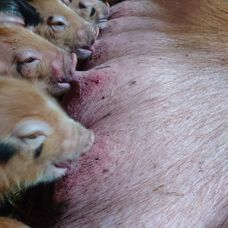
Understanding and Managing Cannibalism in Pigs
In recent months, the Oxford Sandy and Black Pig Group (OSBPG) have seen reports that have surfaced regarding sows and occasionally gilts exhibiting cannibalistic behaviour towards their piglets. These incidents typically occur in the context of large litters, ranging from 12 to 15 piglets, and can happen in both outdoor and indoor farrowings. Despite providing ample space, good lighting, and regular feeding, the sows tend to reduce the litter size to 7 or 9 piglets, indicating a contentment with this smaller size.
The phenomenon of cannibalism in pigs raises questions about its underlying causes.
Is it due to inherent aggression in certain pigs, close breeding, or perhaps a natural response indicating an inability to care for all piglets until weaning age? While some attribute it to shortcomings in husbandry skills, research suggests that cannibalism, termed “savaging,” is a recognised but poorly understood behaviour in pig farming.
Genetic Factors: Savaging is observed across various mammal species, including wild boars, and appears to be more prevalent in species with multiple births. While there are differences in general aggression among domestic pig genotypes, savaging does not necessarily run in families or result from inbreeding. Anecdotal evidence hints at certain commercial genotypes being more predisposed to savaging than others.
Predisposing Factors: Several factors tthat may predispose sows and gilts to exhibit cannibalistic behaviour:
- Poor farrowing environment
- Lack of empathy and inadequate handling
- Possible effects of feed intake (lower intake before farrowing leading to hunger)
- Pain during farrowing
- “Storms” triggered by other savaging females in the same farrowing room
- Inefficient cross-fostering practices
Management Strategies: Addressing cannibalism requires a multifaceted approach which may be considered such as:
- Regular and gentle handling of pregnant gilts, emphasising empathy
- Providing sufficient space for gilts at least a week before farrowing in indoor settings
- Offering bran or grass before farrowing to promote gut health
- Encouraging nest-building behaviour by providing ample straw pre-farrowing
- Playing background music during the farrowing period may have a calming effect
- Identifying problem animals early based on behavioural cues and considering treatments – with advice taken from your Veterinarian
- Confining piglets to the creep area at the first sign of trouble during farrowing
- Avoiding cross-fostering litters onto gilts
- Consider culling sows that exhibit repeated savaging behaviour across multiple litters
In conclusion, cannibalism in pigs remains a complex and challenging issue in pig farming, necessitating a combination of proactive management practices and vigilant observation to mitigate its occurrence and impact on litter survival rates.
The Oxford Sandy and Black Pig Group is UK’s only pig breed that is a registered charity in England & Wales (1190469) and Scotland (SCO52662). We are creating a better future for our breed the bloodlines and it breeding potential together with our Independent Pork Producers, Breeders and Oxford Sandy and Black Keepers and their families. Please click the donate button so we may continue to look after our breed and our supporters
Follow us on Facebook and see how we support, help and inspire individuals about our rare breed Oxford Sandy and Black Pig